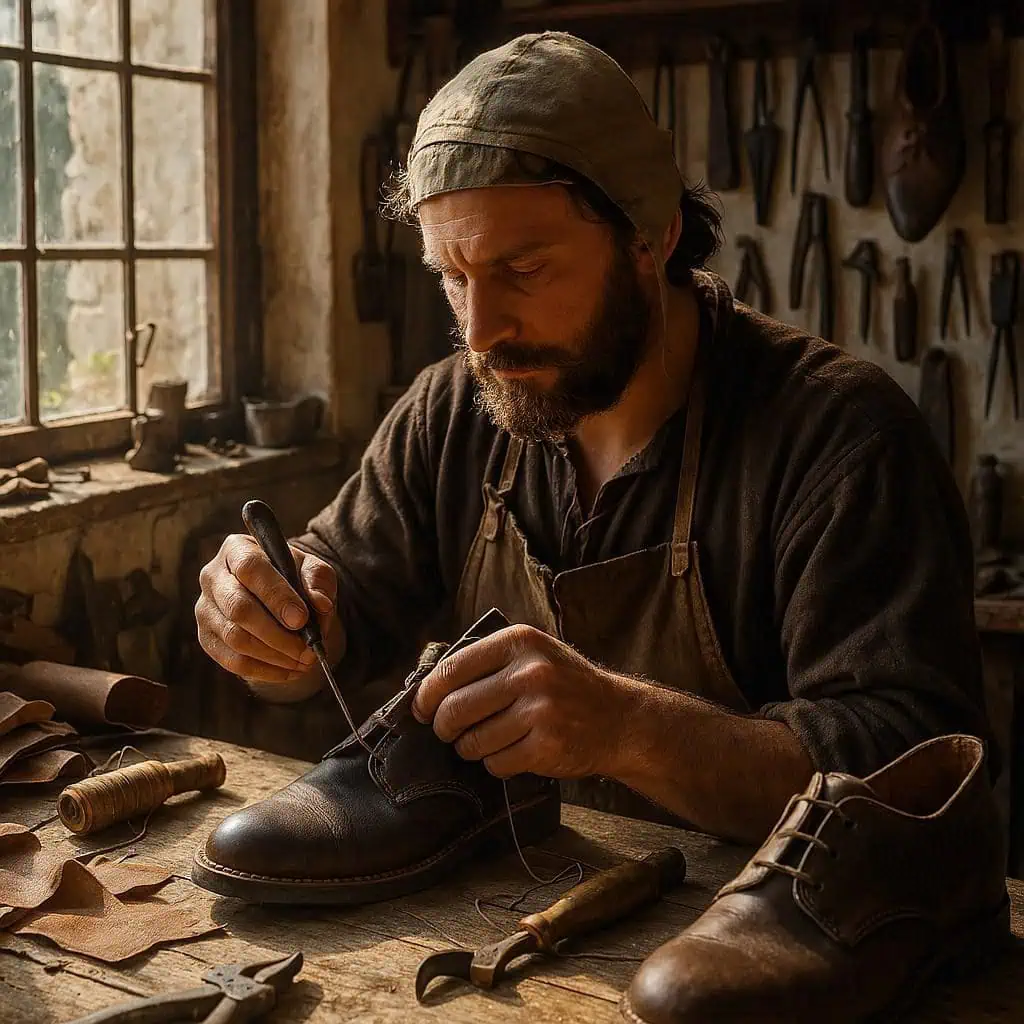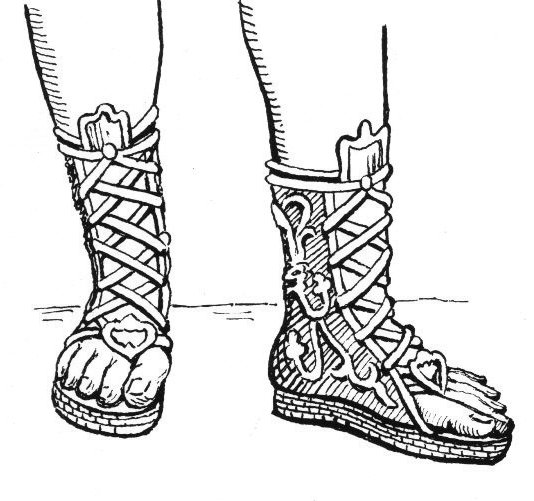Medieval shoes were far more than simple foot coverings — they reflected a person’s status, wealth, and fashion sense in a society where clothing spoke volumes about identity. From the sturdy leather boots of peasants trudging through muddy fields to the extravagant pointed poulaines worn by nobles at court, shoes in the Middle Ages were both practical and symbolic. They protected feet on long journeys, marked social class, and even became the subject of sumptuary laws that tried to limit excess. Exploring medieval footwear reveals not only how people lived and worked, but also how style and symbolism shaped everyday life in the Middle Ages.

Medieval shoe designs became increasingly varied and sophisticated during the middle ages, reflecting the evolving tastes and needs of society. By the late medieval period, the use of stronger and more durable leather became common, allowing for more elaborate and longer-lasting footwear. Additionally, the styles and materials used in these designs began to prominently display a person’s social status and identity. Wealthier individuals often opted for more ornate and finely crafted shoes made from luxurious materials, while those of lower social standing wore simpler, more utilitarian designs. This evolving fashion not only highlighted personal wealth but also served as a symbol of one’s place within the social hierarchy of the time.

Medieval Shoe Types
Medieval shoes came in a variety of different materials and styles throughout the ages, reflecting the diverse cultures and influences of the time. In regions such as France, Spain, and Italy, one particularly well-known type of sandal was called Alpargata. This unique style of footwear gained immense popularity during this era, characterized by its casual yet functional design, making it a favorite among the working class as well as the nobility alike. The combination of comfort and practicality contributed to its widespread use, leading to its iconic status in medieval footwear fashion.
Among the clergy, a type of medieval shoe called ‘Caligae’ was used, inspired by the boots worn by Roman soldiers.

Other common types of medieval shoes included
- Calopedes
- Buskin
- Corked shoes

What were medieval shoes made from?
The most common element used in the making of medieval shows was leather.
Its quality, however, varied over the centuries. Producing the finished Leather was a smelly and messy process that was done by a medieval tanner.

During the early medieval times, leather of low quality was used while late medieval times opened up European trade with the rest of the world and high quality leather became accessible. Other materials used in making shoes included wool and fur etc.
Who made medieval shoes?
Medieval shoes were made by cobblers who also repaired all types of shoes.

However, medieval cobblers mainly made and repaired shoes for the common people. As for the nobility, they had their own shoemaker who was known as a cordwainer.

He made luxury shoes with various styles that were exclusive to the nobility. Compared to the cobblers, cordwainers had more established businesses.
- Earlier medieval shoes were very basic and we usually made from leather
- As the medieval period progressed medieval shoe design improved and the Shaft of shoes was improved
- Medieval shoes began to be worn as a status symbol rather than just something for the feet
- Different people in medieval society wore different types of shoes that suited their profession
- The medieval clergy wore a shoe called a “Caligae”
- Common types of medieval shoes included the buskin cork and calopedes
Medieval Shoes for Men
Various kinds of medieval shoes were popular among the men. Common villagers used shoes that came up to the knees and were wrapped around the front with the laces.
Medieval shoes for nobility and knights, on the other hand, were made of high quality synthetic leather and had low heels. These shoes were available in various styles.
Medieval Shoes Women
Just like men, medieval shoes for women also maintained a distinction between the nobility and the common people. One popular type of medieval shoes for women was the turnshoe.

These shoes were made of thick and soft leather. Among the peasant women, leather of low quality was used and shoes of wool and fur were also common.
Medieval Shoes for Nobility
Medieval shoes among the nobility changed from simpler shoes during the early medieval times to more stylish and sturdier shoes during the late medieval times.
During the middle medieval times, closed shoes with a pointed front were also used by the nobility.

During the 15th century long pointed shoes became very fashionable, these shoes were could be called crakows, crackowes, poulaines or pikes!
History of Medieval Shoes
Medieval shoes, just like medieval clothes, changed their shape and materials over the course of centuries. During the early medieval times, leather of low quality was used in shoes and there was hardly any variety.
However, during the late medieval times, shoes with elaborate designs became popular.
Medieval Shoes Nobility
Medieval shoes were considered a part of person’s attire and served to reflect their social standing. Thus shoes used by nobility were not allowed for the common people. While the main material used in making shoes was leather, fur and wool was also used on occasion.
Medieval shoes were a key marker of social status, occupation, and fashion. Nobles often wore pointed poulaines or elaborately decorated footwear, while peasants relied on simple leather shoes for everyday use. Materials ranged from soft leather and wool to fur, and colors or styles were sometimes restricted by sumptuary laws. Crafted by skilled cobblers, shoes served both practical purposes, like protection from the elements, and symbolic ones, signaling wealth or rank. Over time, these designs influenced Renaissance footwear and remain an important part of the history of European dress.
What were medieval shoes made of?
Most medieval shoes were made from leather, which was durable yet flexible. Wealthier individuals often had shoes lined with fur, decorated with silk, embroidery, or metal accents. The choice of material often reflected the owner’s social status, with peasants wearing simple, sturdy leather while nobles could afford luxury materials.
Who made medieval shoes?
Shoes were crafted by skilled cobblers, who worked by hand in town workshops. Cobblers cut, stitched, and sometimes dyed the leather, adding decorative elements for wealthier clients. Footwear production was a specialized craft, and good cobblers were highly valued in medieval towns.
Why were some shoe styles restricted?
Sumptuary laws were rules that controlled who could wear certain colors, fabrics, or styles. These laws ensured that nobles stood out from commoners. For example, only royalty or the wealthy could wear long-pointed shoes or richly decorated footwear, while peasants were limited to simple, practical designs.
What is a poulaine?
A poulaine is a type of medieval shoe with a long, pointed toe, sometimes extending several inches beyond the foot. It was popular among the nobility in the 14th and 15th centuries. The style was both fashionable and symbolic, showing wealth and status, although extremely long points were sometimes banned by local laws.
Did peasants wear shoes?
Yes, peasants wore simple leather shoes or wooden clogs, designed primarily for practical use. These shoes protected their feet from mud, cold, and rough terrain but were usually undecorated. Unlike noble footwear, peasant shoes were functional rather than fashionable.
How did medieval shoes influence later fashion?
Many medieval designs, like the poulaine, embroidery, and decorative stitching, influenced Renaissance footwear. The evolution of materials, styles, and symbolism in medieval shoes helped shape the history of European dress, leaving a lasting legacy on shoe design and fashion trends in later centuries.






